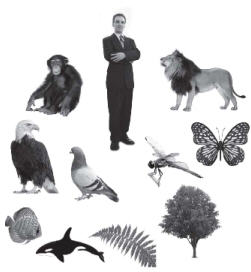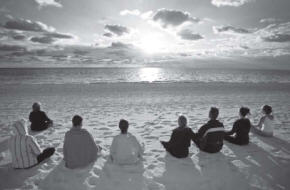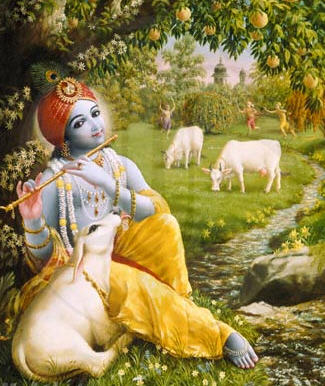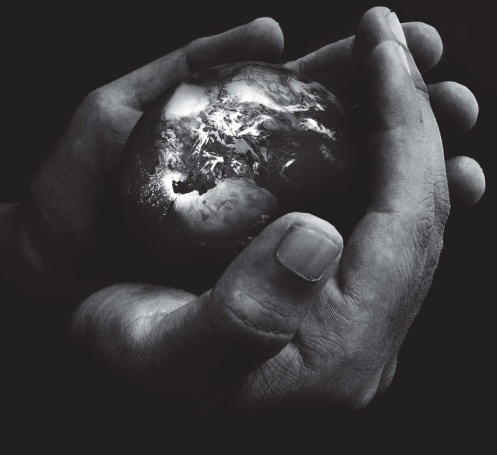Eliminate humans. Will that save the world?
Bubbling over the flames of the contemporary spiritual quest is the perennial hot question: what to do about the world? As a spiritual dabbler or a dedicated practitioner, do I immediately shun the world of pleasures and pains, the dream? Or do I automatically embrace everything in the world as divine?
Humans A Dangerous Species

When we consider the place of humans in this world strictly from the materialistic standpoint, we have no choice but to conclude we are a total disturbance.Better we all take a long hike from this planet never to return.
This sad reality of our material relationship with the world is summed up by Harvard Emeritus Professor E.O. Wilson, one of the most influential biologists of our time: “If all humanity disappeared, the rest of life would benefit enormously. The biosphere would literally breathe a sigh of relief, as forests regenerated and endangered species revived.”
Even with our ecological best behavior, in terms of material presence, we are completely unnecessary in this world. Let any other species disappear ants, for example. Then nature, Wilson says, would incur “major extinctions of other species and probably partial collapse of some ecosystems.”
Humans have become weather-makers; therefore we have everything to fear. The atmosphere and climate have veered far from the norm the result of our sauntering around Earth like drunken sailors on holiday. We are stripping the forests, draining natural resources, and poisoning the land, water, and air by strewing thousands of toxic chemicals to the far corners of the globe.
Despite our preeminent status as weather wreckers, we are the only expendable species in the ecosphere. Knowing that salient biological reality, why not lift our vision? Better we seek our reason for existence in the realm of spirituality. The ancient yoga texts of India champion the human form, with its developed consciousness, as a rare gift from nature specifically for the purpose of spiritual attainment. For example, the Srimad-Bhagavatam (11.9.29) states: “After many, many births and deaths, one achieves the rare human form of life, which, although temporary, affords one the opportunity to attain the highest perfection. Thus a sober human being should quickly endeavor for the ultimate perfection of life as long as the body, which is always subject to death, has not expired. After all, sensory gratification is available even in the lowest and most gross species of life, whereas Krsna consciousness is possible only for a human being.”
This Sanskrit literature, revered throughout India and now also the West, explains: “The human body, which can award all benefit in life, is automatically obtained by the laws of nature, although it is a very rare achievement. This human body can be compared to a perfectly constructed boat having the spiritual master as the captain and the instructions of the Personality of Godhead as favorable winds impelling it on its course. Considering all these advantages, a human being who does not
utilize the human body to cross the ocean of material existence must be considered the killer of his own soul.” (Bhag. 11.20.17)
Human Extinction Is That A Solution?
The same texts alert us to the enormous human potential for spiritual development, latent in both the individual and civilization. Ignoring that dormant spiritual promise, however, what’s left for us? Try the Voluntary Human Extinction Movement.
Popularly known as VHEMT, its planetary strategy certainly provokes thought. Determined to avoid a mad rush to global resource wars and starvation? Terrified by an impending mass die-off, when nature fully retaliates against human overload and abuse? VHEMT urges us to give real peace a chance: all humans unite to stop procreating. Halt the production of new babies now; then watch nature rejoice. In three or four decades, the Earth speeds toward full recovery; by the end of this century, it’s splendidly human-free.
Timely and foreboding, VHEMT’s motto is also cordial: “May you live long and die out.” The movement’s founder, Les Knight, on websites in eleven languages, gently lays our weary species to rest: “The last humans could enjoy their final sunsets peacefully, knowing they have returned the planet as close as possible to the Garden of Eden.”
Thanks for the offer to voluntarily vanish, but no thanks. Generally we feel that other species should run the extinction gauntlet not us humans, the pride of the planet. Nevertheless, our will to survive may propel us through the dire straits to an effective spiritual approach an authentic cure for the greed, materialism, economic injustice, and environmental madness darkening the future. While correcting the spiritual imbalances within us, is it also possible to successfully alter the world around us?
The Two Worldviews

Throughout human history, the major proponents of transformation fall roughly into two camps: the other-worlders and the this-worlders. Eyes raised beyond, the other-worlders accept earthly habitation as only a training school for the hereafter. Withdrawing from the temporal affairs of this temporary world, they concentrate on their own internal development. Like mystic yogis in the Himalayas, the desert fathers of early Christianity, or some monks and nuns of today, they seclude themselves from the din of daily life. All things will pass, and the reward awaits in a higher realm.
The this-worlders, however, live to embrace Planet Earth en toto with all the joys and sorrows. Often avowed reformers, activists, humanitarians, and environmentalists, they plant both their feet and their vision on the ground. Yearning to change the surrounding world economically, politically, and ecologically, they often resent the other-world perspective as a nuisance or worse, a curse. Why siphon valuable potential energy of transformation, so desperately needed to renovate the world, and dreamily project it into the clouds?
Uniting the inner and the outer, the here and the hereafter, is a challenge the Bhagavad-gita meets with consummate majesty. Known as the Gita, for short, it is the standard authoritative text for the complete yoga ladder, presenting both in-world yoga and other-world yoga interlinked. Through a genuine rendition of Gita, the reader will drink at the fount of sacred activism: the precise spiritual technology for truly being in the world while not of the world.

In Chapter Six, for example, “The Yoga of Meditation,” Krsna, the source of all yoga power, instructs: “The perfect yogi, by comparison to his own self, sees the true equality of all beings, in both their happiness and their distress.” (Bg. 6.32) No doubt, some yogis opt for seclusion, focusing upon their own elevation, but another type thirsts to benefit all. The activist yogis, with spiritual strength from the inner world, scan the outer world, noting its grip of impermanent happiness and distress. Striving for more than just their own perfect meditation, the sacred activists reach out to change all dimensions of the living experience. Knowing with compassion the futile struggles of mundane existence, these masters of bhakti-yoga aim for the complete welfare of all creatures. Such fully developed yogis observe the spiritual equality of all living entities, despite nature’s endless pageant of diverse biological costumes.
Let’s say you have just embarked on a spiritual path. You’re chanting your mantra daily, freeing yourself from self-negating addictions, and plunging deep into venerable spiritual texts. Meanwhile, your friends and family observe your newfound zest with curiosity. Slightly amused, they poke you fondly: “Well, little Buddha, what are you going to do about the real world?”
The truth is, you’re not so sure yourself. All you know is that you’re tired of slogging through life with no knowledge of who you are or why whatever is “you” appears in this world. An intuition of your nonmaterial identity coaxes you onward you aspire for at least a preliminary experience of enlightenment. What’s more, your internet research has told you that much of the important knowledge we need to know lies beyond the paradigm of current science. Now, just ahead, looms the famous hurdle how do I act spiritually within the matrix of materialism?
Materialism and Spirituality Finding The Balance
First, let’s take a second look at that sneaky stereotype, “the real world.” By this what we truly mean is the pungent blend of economic, social, and sensual forces that mold us. The shrieks, grunts, squeals, and groans of the university and job marketplace envelope our consciousness as we voluntarily shoulder a lifestyle of study, work, buy, consume, and die. Somehow, this volatile yet dreary manner of human affairs has been consecrated as the standard for evaluating all our achievements in life.
The Srimad-Bhagavatam (2.1.3) allows us to see that the daytime of the materially overwhelmed person means complicated, often computerized versions of basic onsciousne pursuits. Hunting and gathering, we muscle and connive our way through the forest of education and employment. Darkness falls; we seek release.
We pin our hopes for redemption on a nocturnal brew of television, intoxication, and sex. The warm blanket of sleep grants us a temporary reprieve; but too soon day breaks, and the cycle of intense struggle renews.
Why do we take what is so tedious, so deadening, so self-destructive and anoint it as the real world? How did we succumb to such low expectations of human potential?
The lifestyle of the genuine spiritual practitioner will triumph. Gradually the awareness will dawn that our highest spiritual aspirations and expressions are the day-to-day essence of true human life. A host of Krsna-conscious adepts can testify how bhakti-yoga reorders a person’s lifestyle and relationships so that the spiritual energies flowing from the Supreme Soul, Krsna, assume their rightful pride of place.
This spiritual transformation culminates with entrance into divine vision and connectivity. In the Bhagavad-gita, Krsna Himself describes the real world in this way: “A true yogi observes Me in all beings and also sees every being in Me. Indeed, the self-realized person sees Me, the same Supreme Lord, everywhere. For one who sees Me everywhere and sees everything in Me, I am never lost, nor is he ever lost to Me.” (Bg. 6.29-30)
Progress on the Spiritual Path

Available in increments, as the spiritual aspirant progresses, this attraction for the supreme source of pleasure reshapes our life. Gradually we perceive that the world is a combination of material and spiritual energies emanating from Krsna, the ultimate fount. Krsna’s energies are not ours to plunder or exploit, nor to discard or negate.
Since everything, whether matter or spirit, is the energy of the Supreme, therefore we necessarily must strive to hear from the Supreme how to cope. A fundamental principle of existence is that we cannot concoct our own style of interactions with those energies. Look at the earth, the sky, the water. The deepening ecological crisis reveals that unaided by knowledge from Krsna we are just too arrogant and tiny to handle material nature. Next, honestly look inside peer at our own minds. We don’t even know ourselves, what to speak of understanding how to handle the self or nature.
Disaster Looming Ahead
Your grandchildren could see half the species of plants and animals on this planet either gone or on their way out. Scientists estimate that by the end of this century, if the human impact on nature continues at the present rate, then the fifty percent curtain will fall. The most conservative estimates of the current extinction rate say it’s one hundred times beyond what happened on Earth before humans are said to have appeared. In the immediate decades ahead, the extinction pace driven by climate change is expected to worsen a thousand times or more. Naturally, the global repercussions to this human handiwork are frightening.
Beyond a doubt humans have demonstrated a destructive power that expands without limit. Nevertheless, from the Earth’s point of view, our actual biomass is almost microscopic. E.O. Wilson gives us a thought experiment to highlight this strange paradox. We are the first species in the known history of life to become a geophysical force, yet it is mathematically possible to round up all the offenders the homo sapiens stack us like sardines into a space measuring just one cubic mile, and then tuck away all of us in some lonely section of the Grand Canyon.
The Spiritual Solution
Humanity, what to do? From the remote antiquity of spiritual India, the Upanisads call: “Only a miserly person lives and dies like the cats and dogs that is, never using the human potential to solve the puzzle of how to live, never grasping the science of self-realization.” But at least in westernized countries, cats and dogs are our best friends, so what’s wrong with living like them? As for death, it happens, just as taxes do.
Two-and-a-half thousand years ago, the classic Greek philosopher Socrates declared, “The unexamined life is not worth living.” But the attempt at civilization that dominates the world today is confident it has proven Socrates wrong. Commandeering the best intelligence, it enforces the grand solution: make money and indulge your senses on a global scale lasting peace and prosperity will somehow follow.
Half a century ago, the famed French philosopher Albert Camus concluded, “There is only one truly serious philosophical issue: suicide why not?” Be brave, put yourself on the spot, he urged. Is there any point at all to existence? Admit the absurdity, and then you can decide for yourself whether your life in the biosphere is worth living.
My home-base is New Zealand, rated by the UN as the most ecologically conscious nation in the world. Amidst some of the most beautiful nature on Earth, 1 in 6 New Zealanders think of committing suicide annually, 1 in 18 make a plan for it, and 1 in 22 actually attempt. Because people hesitate to admit such behavior, the statistics are considered lower than the reality. “It’s too peaceful here, too serene our minds drive us crazy,” especially many small-town and rural youth complain. “The only thing to live for is that we can get stoned, completely wasted, in awesome natural beauty.” For all three suicide prevalences, the median ages of onset are in the twenties.
Enter the Real World

Whether to deny life or affirm it, bhakti-yoga, the timeless science of supramundane devotion, teaches us that we cannot decide based solely upon our own, limited intelligence. In the same way, justification to either reject or affirm the world also lies beyond our tiny faculties. Since we, as bodies of matter and souls of spirit, are energies of the Supreme, our human existence has a built-in imperative. For sane management of both the energies composing us and the energies surrounding us, we must take lessons from the supreme reality, Krsna.
A surgeon’s knife in the hand of a medical expert can accomplish great good, but that same tool in the hands of a murderer will unleash horror. A genuine spiritual practitioner seeks to neither reject the body nor indulge it; neither coldly spurn the things of this world nor passionately embrace them.
The goal of authentic yoga and meditation is to take guidance from the source of all energies, the Ultimate Proprietor, and learn how to deftly use even the temporary material body and the temporary material world as springboards to spiritual freedom. Welcome to the real world. Bhakti-yoga, Krsna consciousness, is the perfection of the Information Age.
His Holiness DevamRta Swami is a sannyasi in ISKCON and a disciple of Srila Prabhupada. He is a teacher and author who speaks at universities, colleges, businesses, and temples around the world.
